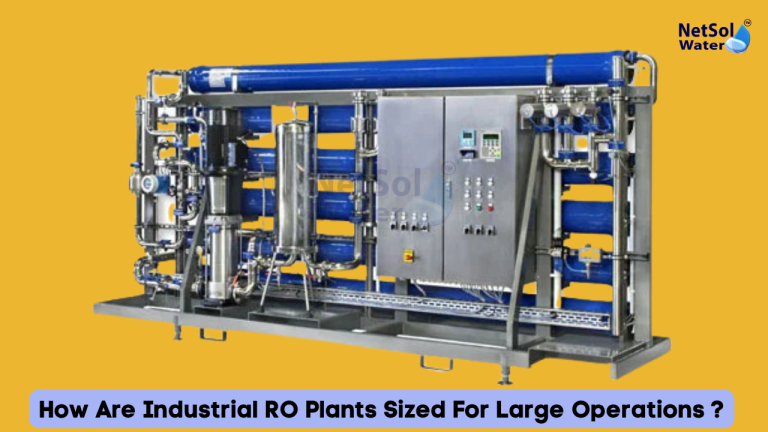
Sizing an industrial RO plant for large operations is a major step in ensuring the efficiency and effectiveness of water treatment systems. When it comes to large-scale operations, such as manufacturing plants, power plants, or large commercial facilities, the capacity and configuration of the RO plant must be carefully determined to meet the specific water demand. If not sized correctly, it can lead to inefficiencies, unnecessary costs, and even failure in meeting water quality standards. In this blog, we will explore the factors that determine how industrial RO plants are sized for large operations, and why proper sizing is key to success.
Key Factors in Sizing Industrial RO Plants for Large Operations
In the sizing of an industrial RO plant for large operations, various items need to be considered. These are necessary so that the system will be able to supply the required amount of water without compromising performance. The following are items of major concern during the sizing of industrial RO plants.
1) Water Demand
Water demand by the operation is the most essential to consider in sizing an industrial RO plant. Manufacturing industry at large industrial scales utilizes a large quantity of water, and RO plant size shall, therefore, be calculated appropriately in order to fulfill current as well as future demand. Demand will be the function of the industry class, condition of processes, and period of operation. There needs to be a definite understanding of the volume of total water usage so that the RO plant can be supplied with a definite amount of water that is purified.
2) Feedwater Quality
Feedwater quality coming into the system is another driving force that decides the capacity of the RO plant. Low-grade water, say water with high TDS, hardness, or impurities, would require additional stages of filtration and bigger membranes to provide the desired level of water quality. Higher quality feedwater will, however, require less severe treatment, and this will allow for a denser and more efficient system. Proper sizing of the plant requires carrying out a complete feedwater quality analysis.
3) Purified Water Quality Specifications
The exact quality parameters of the treated water will determine the design of the system. The water quality parameters may vary from industry to industry depending upon the nature of industry operations. For example, in pharmaceutical or food processing industries, the water needs to be of extremely high quality. The higher the quality required, the more sophisticated the RO plant must be, and this can influence its size and quantity of membranes. Having specific specifications for water quality guarantees that the system is adequately sized to meet these requirements.
4) Recovery Rate
Recovery rate is the percentage of feedwater converted into purified water by the RO process. High recovery rate will yield less waste, but it may also increase the stress on the RO membranes. Bringing the rate of recovery up to optimal system capacity is required. A high recovery rate can prevent wastage of water, but it may require a larger RO plant to handle the increased filtration load and prevent scaling or fouling issues.
5) System Efficiency and Operation Times
Its scale also depends upon the performance efficiency of the RO plant and running time of the plant. Under 24/7 large operations, the RO plant shall be designed so that it will function day and night without stopping. Its power consumption efficiency, requirement of pressure, and performance capability of membranes are also given careful consideration so that the system has to be worked economically and effectively.
6) Future Expansion Requirements
When designing an industrial RO plant for big operations, future expansion must be considered. When the companies grow and require more water, the RO plant must be designed to expand in order to meet those requirements. Planning the system to expand in the future could be cost-saving in terms of future system upgrade costs.
How Industrial RO Plants Are Designed for Large Operations
Once the key parameters are assessed, the industrial RO plant is designed and configured to deliver the water treatment needs of big operations. The design can incorporate several stages of filtration, including pre-filtration, reverse osmosis, and post-treatment steps. These are the common configurations of large-scale industrial RO plants:
1) Multistage RO plants: For big water processes with high requirements, multistage RO plants are used to be more efficient and with higher capacity.
2) Modular RO Plants: Modular systems are flexible and can be modified as water requirements grow. Modular systems consist of a series of modules that may be added or deducted to change the capacity.
3) Energy Recovery Systems: Large operations normally need energy recovery systems to minimize energy consumption. These systems facilitate the recovery of energy in the concentrate stream, enhancing efficiency in the RO plant.
Conclusion
Proper sizing of industrial RO plants for bulk operation is essential to render water treatment plants efficient as well as effective. Considering factors such as water demand, feedwater quality, quality of purified water to be produced, recovery rate, and future expansion potentiality, companies can ensure their RO plant is sized appropriately to fulfill their needs. So these are the factors where we can say that How Are Industrial RO Plants Sized For Large Operations. Adequate sizing not only helps achieve maximum performance but also helps achieve cost-effectiveness and sustainability in the long run.
Do you need an advice or assistance on selecting the best water and waste water treatment unit? We have solutions for all your problems!
Let us know your problem, our experts will make sure that it goes away.
For an assistance or related query,
Call on +91-9650608473
Or write us at enquiry@netsolwater.com
